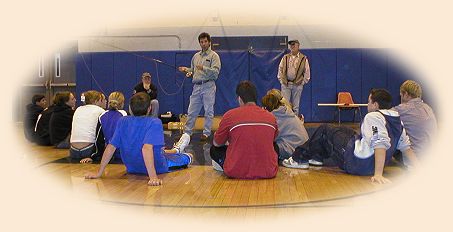
Beauty is in the eye of the beholder:
truth, too, in fly tying. But, since
the eventual "beholders" will be locked
under ice for a few months here in Maine,
the best judges of these flies are their
creators. The artists at hand are high
school physical education students. They
are part of the phoenix of our junior high
program, now a casualty of a schedule change.
Instead of struggling to recreate a junior
high/middle school program, a more reasonable
effort spawned a threefold partnership: junior
high (my four years with integrating fly fishing
into the regular curriculum), high school (they
had kids and were looking for real life experiences)
and our local Trout Unlimited chapter (a
wealth of experience, equipment, and expertise).
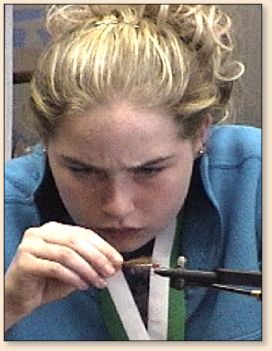
"Look at this one!" An outstretched hand
with perfect purple fingernails displayed
a pink chenille wooly worm wrapped with a
purple feather. "My last one was black
with a green feather. Isn't this cool?"
Her good friend, Jake, raised one eyebrow
to their other tablemates. Friendly laughter.
Good fun.
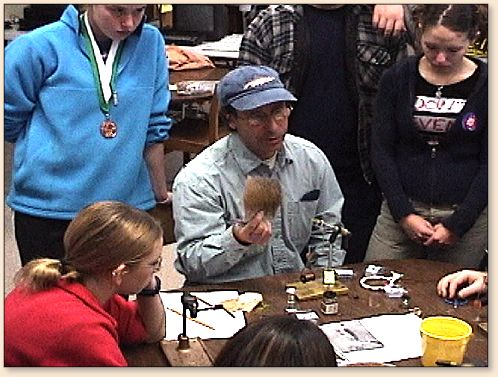
Jake showed us his fly, gray chenille,
grizzly hackle, a tidy size 16. He
grinned and shrugged. "Different strokes."
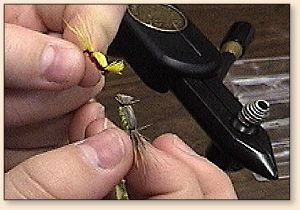 I love these borrowed high school kids.
I love middle school kids, too, to be
sure, but these guys are so...old. Witty.
More confident. Hidden talents. They do
seem to tie a little slower that my 12
year olds, but there's certainly less
debris on the floor.
I love these borrowed high school kids.
I love middle school kids, too, to be
sure, but these guys are so...old. Witty.
More confident. Hidden talents. They do
seem to tie a little slower that my 12
year olds, but there's certainly less
debris on the floor.
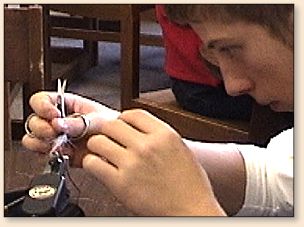
This was our third session together. Before
the first, the two high school physical
education teachers split their class, giving
students the option of trying fly fishing or
continuing with regular activities. The fly
fishing half was limited to 15 to 20 kids for
each of three teaching blocks. Meanwhile,
I contacted Greg, my key TU mentor from the
past years at middle school, and tested the
waters. He was both willing to come and
willing to round up help; just name the
dates. Back to the teachers; no date
preference. Pausing at the calendar, I
consulted my principal and found dates least
likely to impact my own students if she freed
me up to assist in high school phys ed on four
days. Tuesdays in October it was, confirmed
by the TU volunteers and high school teachers.
Other details followed a similar route.
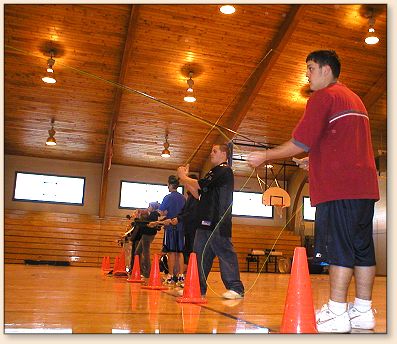
There is a certain amount of jumping through
hoops figuratively before casting through
hoops literally. I had to hand it to my
TU volunteers. After four years of unflagging
support with my middle school program, their
middle school program, they didn't bat an eye
when I proposed they invest a big part of their
free time teaching high school kids in a school
district that had just forced us out as
collateral damage. The middle school had
no intention of doing away with fly fishing;
never even thought about it when instituting
an anti-bullying advisor program in the same
time slot.
It took me longer to see the humor in the
situation: a semester of twelve kids with
three community mentors who guide them through
a shared passion for fly fishing replaced by,
hmmm, a commercial program intended "to match
a few kids with an adult who cares and give
them a common basis for understanding as well
as life long skills and a link to the community?"
Such is school. Jumping through hoops all over
again is just jumping through a few more hoops.
No big deal. My own principal was among the most
supportive, assuring me time out of the library
to help out at the high school.
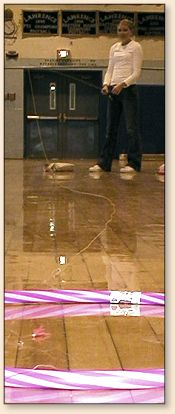 We combined our past experiences with the
class objectives and national standards,
creating four seventy-minute lessons.
Nothing flashy, nothing any angler couldn't
do. During the first block, our students
learned the terminology for the equipment
as well as proper care and assembly (and
disassembly) of the gear. Then we sent them
to mentored basic casting in pairs along the
center line of the gym. Orange cones marked
the lanes. After two blocks, I headed back
to my school for two hours, and the high school
treated the TU mentors to cafeteria lunch in
the lively confines of the Teachers' Room.
Obviously brave and adventurous, these three
guys. During study hall, they had a moment
to slip down to the local fly shop. Then we
taught one more class, complete with school
fire drill (why not?). After that block,
we planned for the casting situations the
next Tuesday.
We combined our past experiences with the
class objectives and national standards,
creating four seventy-minute lessons.
Nothing flashy, nothing any angler couldn't
do. During the first block, our students
learned the terminology for the equipment
as well as proper care and assembly (and
disassembly) of the gear. Then we sent them
to mentored basic casting in pairs along the
center line of the gym. Orange cones marked
the lanes. After two blocks, I headed back
to my school for two hours, and the high school
treated the TU mentors to cafeteria lunch in
the lively confines of the Teachers' Room.
Obviously brave and adventurous, these three
guys. During study hall, they had a moment
to slip down to the local fly shop. Then we
taught one more class, complete with school
fire drill (why not?). After that block,
we planned for the casting situations the
next Tuesday.
Late notice came that the first block on the
following Tuesday would be set aside for
district-wide writing assessment, all students
writing to a prompt for eighty minutes. We'd
be one class short. Un-phased, we used the
disrupted schedule to set up in the gym. Our
plan was to have six stations. After some
brief instructions and some discussion of
real world casting situations, students in
pairs or threes would move to a station,
try it, and move on in an eight minute
rotation.
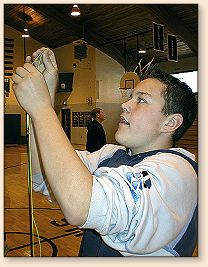
Stations were varied. One involved casting
30 feet to touch the fly on a floor cone nestled
between two chairs; the next, sitting to do the
same (canoe posture). A station in front of a
basket involved casting under the hanging web
of net, but through the equipment room door
(loop size exercise). There was a T-shaped
obstacle at another station, and students tried
to place the fly under the right then left
overhang. Successive hula-hoops lying on
the floor provided incremental distance
targets at the next station. The last, to
practice small loops for casting into the wind,
involved casting through an upright hula-hoop
taped to a chair for support but required the
fly to land beyond the hoop between cones on
the floor. Many of these ideas we'd been given
at an L.L. Bean workshop arranged by TU with
this very outcome in mind.

The kids loved it. At least one station was
challenging for every student, and some found
them all tough. With an angler as mentor at
every station, there was help available, although
we were careful not to hover or butt in too much.
Give the kids space, give them encouragement,
give them a safe chance to learn. They all did.
I particularly enjoy the part when an impossible
task becomes a possible cast. The pride is
priceless. A couple mastered every station
quickly, and we set them to casting to the
letters on the gym floor spelling out the
school's name and mascot (no false casts, please!)
The two teachers traded off which half of the
class they were teaching, fly fishing or weight
training, so that they would both have a chance
to be involved.
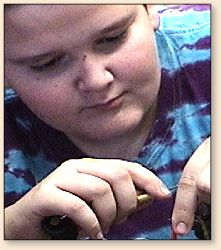 To tie, we switched from the gym at the high
school to my library where we had tables. It
felt like old home week to the kids and me.
Every one of them had been in my library a
good part of their junior high experience. For
my part, I'm the only middle school teacher who
gets every student for two full years, plenty
of time to grow close. I always wonder how
they all turned out, life after eighth grade.
To tie, we switched from the gym at the high
school to my library where we had tables. It
felt like old home week to the kids and me.
Every one of them had been in my library a
good part of their junior high experience. For
my part, I'm the only middle school teacher who
gets every student for two full years, plenty
of time to grow close. I always wonder how
they all turned out, life after eighth grade.
The plan had been to integrate economics,
conservation, and other topics during the
fourth session, but time was spread too thin.
We opted to do it subtly as we tried tying
again, refreshing kinestic memory by first
tying the same fly and then going on to
others. Revisions may be in order for the
next semester's groups.
Maine has a well-established tradition in the
outdoors and the role of our junior high program
in piquing interest early in these particular
students can't be discounted. Still, if it
doesn't exist there already, I would champion
the consideration of a like offering for other
schools. For both immediate rewards and
eventual promise, it's hard to match.
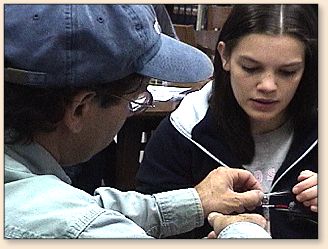
In that third session, Dawn, who never speaks,
ventured out. "I brought these in." Her voice
was so quiet we almost missed it, but the
offering was precious. She had arrived with
a baggy of beautiful streamers, all hers. It
was her classmates' turn to be quiet.
"You tied those?" Jake asked.
Dawn smiled.
Later, Greg sat down with his dubbing box and
gave Dawn a next step lesson; she embraced it.
As someone outside the school, he had no way
of knowing how much she struggles. It had
seemed to me like she'd be forever in junior
high, a bright technical star in my television
studio until the core curriculum teachers pulled
her out of extra curriculars for never completing
her homework. Her sympathetic gym teacher and
I exchanged happy glances; this was worth any
extra effort.
Jake wandered over to finger the bright
streamers, black and red and orange and
white, all kinds. "They're beautiful!"
he told her.
"I think so," Dawn said. ~ Kat
About Kathy:
Kathy noted in her first contacts with us that interest in kids' programs have
really picked up in Maine. She says, "You are absolutely correct in saying the
folks at the state level are helpful and appreciate the interest. I've
also found our local chapter of TU very receptive, as well as the assorted
Registered Maine Guides and the local fly shops. At the National level,
Greg Ponte received TU's "Distinguished Service Award" for kids outreach
work in Maine, and middle schools are becoming so interested I received an
"Exemplary Practice" award from the Maine Associate of Middle Level
Educators for my program for 7th and 8th graders. Gred, Tim Soule
(a member of FAOL) and I presented at the state middle school teachers'
conference this fall."
Kathy is also the author of Moose in the Water Bamboo on the Bench,
reviewed in our Book Review section (it's really delightful) and
Headwaters Fall as Snow. She welcomes
contact from others wanting to set up a similar program in their
schools. She is a full-time teacher, you can reach her by email
at:
dpvbkjs@tdstelme.net
|




 I love these borrowed high school kids.
I love middle school kids, too, to be
sure, but these guys are so...old. Witty.
More confident. Hidden talents. They do
seem to tie a little slower that my 12
year olds, but there's certainly less
debris on the floor.
I love these borrowed high school kids.
I love middle school kids, too, to be
sure, but these guys are so...old. Witty.
More confident. Hidden talents. They do
seem to tie a little slower that my 12
year olds, but there's certainly less
debris on the floor.

 We combined our past experiences with the
class objectives and national standards,
creating four seventy-minute lessons.
Nothing flashy, nothing any angler couldn't
do. During the first block, our students
learned the terminology for the equipment
as well as proper care and assembly (and
disassembly) of the gear. Then we sent them
to mentored basic casting in pairs along the
center line of the gym. Orange cones marked
the lanes. After two blocks, I headed back
to my school for two hours, and the high school
treated the TU mentors to cafeteria lunch in
the lively confines of the Teachers' Room.
Obviously brave and adventurous, these three
guys. During study hall, they had a moment
to slip down to the local fly shop. Then we
taught one more class, complete with school
fire drill (why not?). After that block,
we planned for the casting situations the
next Tuesday.
We combined our past experiences with the
class objectives and national standards,
creating four seventy-minute lessons.
Nothing flashy, nothing any angler couldn't
do. During the first block, our students
learned the terminology for the equipment
as well as proper care and assembly (and
disassembly) of the gear. Then we sent them
to mentored basic casting in pairs along the
center line of the gym. Orange cones marked
the lanes. After two blocks, I headed back
to my school for two hours, and the high school
treated the TU mentors to cafeteria lunch in
the lively confines of the Teachers' Room.
Obviously brave and adventurous, these three
guys. During study hall, they had a moment
to slip down to the local fly shop. Then we
taught one more class, complete with school
fire drill (why not?). After that block,
we planned for the casting situations the
next Tuesday.

 To tie, we switched from the gym at the high
school to my library where we had tables. It
felt like old home week to the kids and me.
Every one of them had been in my library a
good part of their junior high experience. For
my part, I'm the only middle school teacher who
gets every student for two full years, plenty
of time to grow close. I always wonder how
they all turned out, life after eighth grade.
To tie, we switched from the gym at the high
school to my library where we had tables. It
felt like old home week to the kids and me.
Every one of them had been in my library a
good part of their junior high experience. For
my part, I'm the only middle school teacher who
gets every student for two full years, plenty
of time to grow close. I always wonder how
they all turned out, life after eighth grade.